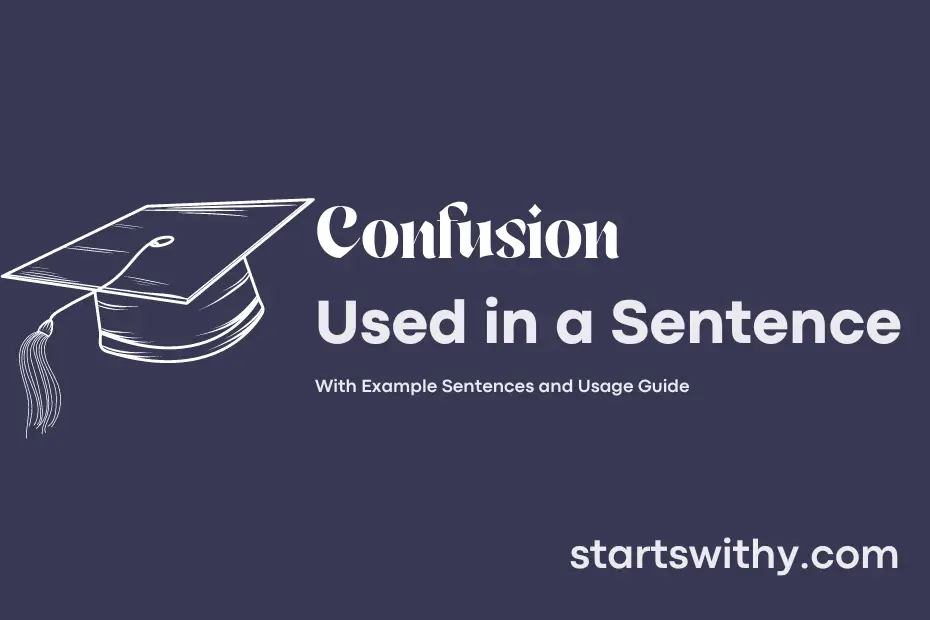Have you ever felt perplexed or uncertain about a certain topic or situation? This state of mental ambiguity and uncertainty is what we refer to as confusion. It’s the feeling of being unsure, unclear, or disoriented about something.
Confusion can arise from a variety of factors such as lack of information, contradictory messages, or simply a complex topic. It can hinder our ability to make decisions, understand concepts, or effectively communicate with others.
7 Examples Of Confusion Used In a Sentence For Kids
- Confusion happens when we don’t understand something.
- When we feel confusion, it’s good to ask questions for help.
- Sometimes we can feel confusion when learning new things.
- It’s okay to feel confusion, it means we are learning.
- If we are in confusion, we can talk to our teacher for clarification.
- Taking a deep breath can help us when we are in confusion.
- We can work together with a friend to solve confusion.
14 Sentences with Confusion Examples
- Many college students in India experience confusion when choosing a major.
- The complicated assignment instructions caused confusion among the students.
- Balancing academics, extracurricular activities, and social life often leads to confusion for college students.
- The last-minute change in the exam schedule caused a lot of confusion among the students.
- The professor’s vague explanation only added to the confusion about the project requirements.
- Trying to navigate the complex college bureaucracy can cause confusion for many students.
- The variety of career options available can leave students feeling overwhelmed with confusion.
- A lack of clear communication from the administration led to confusion about the registration process.
- The numerous deadlines for assignments and projects often result in confusion for students.
- The conflicting advice from different professors left the students in a state of confusion.
- The sudden change in the syllabus created confusion among the students about what topics to focus on.
- The technical issues with the online learning platform caused confusion for students trying to access their lectures.
- The overlapping deadlines for multiple assignments caused confusion among students trying to prioritize their workload.
- The complex grading system used by some colleges in India can lead to confusion about how student performance is evaluated.
How To Use Confusion in Sentences?
To use the word Confusion in a sentence, first, you need to understand its meaning. Confusion refers to a state of being bewildered or unclear about something. When using the word in a sentence, it’s essential to ensure that it accurately conveys a sense of disorientation or lack of understanding.
Here are some examples to help you better grasp how to use Confusion in a sentence:
- The new instructions left me in total confusion about what to do next.
- The sudden change in plans caused a lot of confusion among the team members.
- Her mix-up of dates resulted in confusion for everyone involved in the event.
- The complex information presented in the lecture led to widespread confusion among the students.
- Trying to follow the directions without a map only added to the confusion of getting lost.
Remember to place the word Confusion in a context that clearly reflects a lack of clarity or understanding. By using it appropriately in a sentence, you can effectively convey the feeling of being confused or disoriented. Practicing with different examples will help you become more comfortable incorporating Confusion into your sentences.
Conclusion
In conclusion, sentences with confusion can occur when there is a lack of clarity or understanding in the way information is presented. These sentences can lead to misunderstandings, miscommunication, and difficulty in interpreting the intended message. It is important to strive for clear and coherent communication to avoid confusion and ensure that ideas are conveyed effectively.
By being mindful of sentence structure, word choice, and providing sufficient context, we can minimize confusion in our writing and conversations. Clarity and simplicity in sentences can help deliver messages that are easily comprehensible and reduce the likelihood of confusion. By making a conscious effort to communicate clearly, we can enhance understanding and ensure better communication overall.



